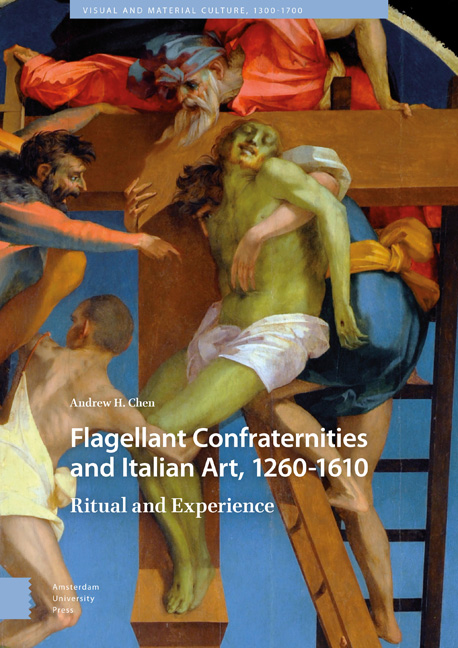Book contents
- Frontmatter
- Deduction
- Contents
- Abbreviations
- List of Illustrations
- Acknowledgements
- Introduction
- Part I Art and Ritual, to 1450
- 1 Flagellation and Its Settings
- 2 Images at Entrances, and Ascesis
- 3 Mass
- 4 Comforting
- 5 Processions
- Part II Transformations
- 6 Changes in Ritual Before Trent
- 7 Changes in imagery before Trent: Sansepolcro and Volterra
- 8 After Trent: Florence and Milan
- Epilogue: Global Flagellation
- Bibliography
- Index of Illuminated Manuscripts (by location)
- Index of Paintings (by location)
- Index of Topics
- Frontmatter
- Deduction
- Contents
- Abbreviations
- List of Illustrations
- Acknowledgements
- Introduction
- Part I Art and Ritual, to 1450
- 1 Flagellation and Its Settings
- 2 Images at Entrances, and Ascesis
- 3 Mass
- 4 Comforting
- 5 Processions
- Part II Transformations
- 6 Changes in Ritual Before Trent
- 7 Changes in imagery before Trent: Sansepolcro and Volterra
- 8 After Trent: Florence and Milan
- Epilogue: Global Flagellation
- Bibliography
- Index of Illuminated Manuscripts (by location)
- Index of Paintings (by location)
- Index of Topics
Summary
A 1758 Santa Maria della Morte inventory contains a reference to seven ‘small panels, where there is painted the Passion of Our Lord, and Holy Martyrs, which are for the patients’. The function of the Bolognese tavoletta is shown in the illuminated frontispiece of a fifteenth-century copy of the Santa Maria della Morte confraternity’s manual for comforters (Plate 11). At the upper left, a prisoner wearing a blue tunic stands framed by the entrance door of the city prison. Hooded members of the confraternity gather behind him, and a comforter wearing a dark knee-length sleeveless garment over a white shirt holds a little gilded panel up to his face. A soldier stands guard to the left. In the scene to the upper right, the prisoner is bound to a column while his sentence is read out to the people from atop a large gate. Now a hooded confratello is the one keeping the panel raised in front of the condemned man's face. At the bottom of the page, the prisoner is led through the street toward the execution site, preceded by an armed cortège of horsemen and foot soldiers. One confraternity member makes a gesture showing the way. The tavoletta is still being held close to the prisoner's face; a second hooded brother plies the man with consolatory words and gestures. The man in pink at the rear, who is shown next to the condemned man also in the previous scene, keeps the prisoner's hands secured behind his back.
From the text we learn that sentences were read aloud from the parapet of the Palazzo del Podestà; the prisoner was then processed around the piazza and through the street toward the Monte del Mercato. The manual advises that while walking through the street prisoners will be easily distracted by all of the people gathered to watch, so the comforter should occupy him with prayers and other ‘pleasant sayings’. The prisoner would attend his last mass at the church of San Giovanni Decollato, where, the text says, there will be many flagellants in the crowd. At the execution site, he confesses to a priest, at the urging of the comforter, and then proceeds to the execution block or the gallows.
- Type
- Chapter
- Information
- Flagellant Confraternities and Italian Art, 1260–1610Ritual and Experience, pp. 123 - 140Publisher: Amsterdam University PressPrint publication year: 2018

